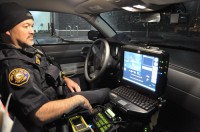The Portland Police Bureau is asking the City Council for funding to install video cameras in squad cars.
Several traffic division vehicles are already outfitted with cameras and the bureau is hoping to expand camera installation to include 10 squad cars. As the bureau experiences scrutiny from the community and the Department of Justice, the cameras are viewed by proponents as an opportunity to alleviate concerns about police brutality.

Last year was difficult for the bureau. There were eight officer-involved shootings, which resulted in massive media coverage and community outcry. A civil investigation was launched by the DOJ into allegations of excessive force. The DOJ declined to comment on this ongoing investigation.
In March 2011, the PPB released a report that analyzed these shootings. In six out of eight of the incidents, the suspect was “threatening or actively assaulting another citizen,” according to the PPB. Additionally, six out of eight of the suspects were mentally ill and under the influence of alcohol and/or drugs, and all of the suspects were armed.
Lieutenant Robert King adds that in 2010, PPB had 400,000 citizen contacts, 30,000 arrests and 1,273 incidents involving the use of force; this breaks down to .31 percent of police contact with citizens resulting in the use of force. “Independent [Police] Review looks very closely at our force and we are as low as any comparable organization,” King said.
The Seattle Police Department has had cameras in their vehicles since 2007. In 2002, the department launched a pilot program in response to allegations of racial profiling during traffic stops. According to Detective Mark Jamieson, public information officer with SPD, the department responded to concerns raised in the community with a number of measures, including cameras in squad cars.
“We’ve had our share of controversies as well—but we have had officers exonerated once video footage was reviewed,” Jamieson said.
He added, “Cameras are a tool—not a silver bullet.”
Many smaller police departments in Oregon already have video cameras in all of their cars. Gladstone Chief of Police Jim Pryde sees cameras as an important tool.
“Officers are confronted with human frailty on a daily basis—mentally ill, addiction, those who have fallen through the cracks. Never before has it been more challenging to be a police officer; the expectations can be daunting,” Pryde said.
He believes that “because law enforcement has the power to take away civil rights, the power to use excessive force and—if needed—the power to take a life,” law enforcement needs to be held to a higher level of accountability, which cameras may provide.
A 2002 multi-dimensional study on the impact of in-car cameras published in Police Chief Magazine showed that video improved officer safety and professionalism, and reduced complaints dramatically. The recorded footage allows officers to review interactions for safety issues such as turning their back on a potentially dangerous individual, and many officers believed that notifying citizens that they were being recorded “deescalated situations that they felt were becoming confrontational,” according to the study.
The study also revealed that 50 percent of complaints against officers were dropped when the complainant learned the interaction had been recorded. Of the complaints that were actually filed, 96.2 percent of officers were exonerated when video footage was reviewed.
Video also provides compelling evidence during criminal investigations and trials. Jamieson noted that the SPD have had great success utilizing video as evidence in court proceedings. For example, during a DUI hearing the defendant appears sober before the court and disputes the officer’s claims about their intoxicated behavior. When the video footage is produced, the ruling is no longer a product of the officer’s word versus the defendant’s because “video does not lie; it is really powerful evidence,” Jamieson said.
Dow noted that due to television programs like CSI: Crime Scene Investigation on CBS, many people already believe that squad cars have video. Suspicions can be raised in the absence of video. “Juries are skeptical when there is no video produced as evidence,” Dow said.
“This is all part of the technological revolution for law enforcement,” King said.
Dow continued to say that “we think we are doing a good job, but we feel like we have to prove it to the community.”
He believes that cameras will provide an impartial account of situations that arise.
“With events like the recent officer-involved shootings, the bureau won’t be able to appease everyone, but if there is video that can show the true nature of the shooting, it may help the community to understand our job,” Dow said.

